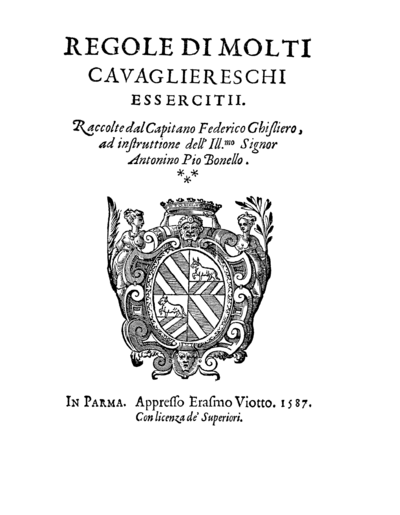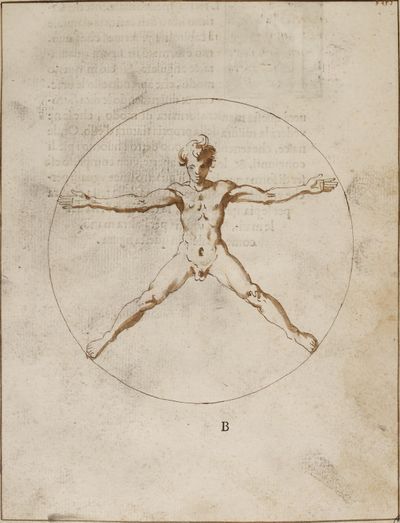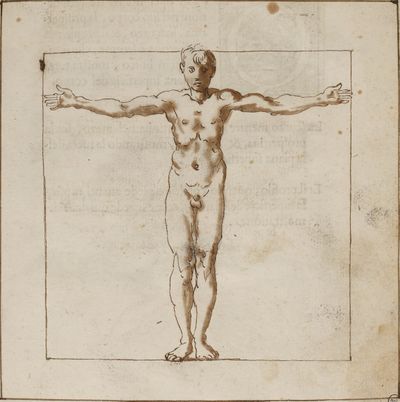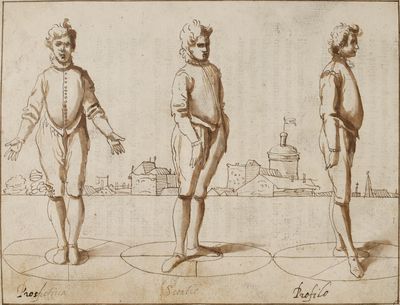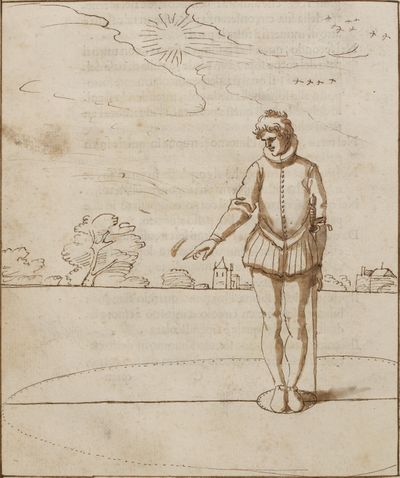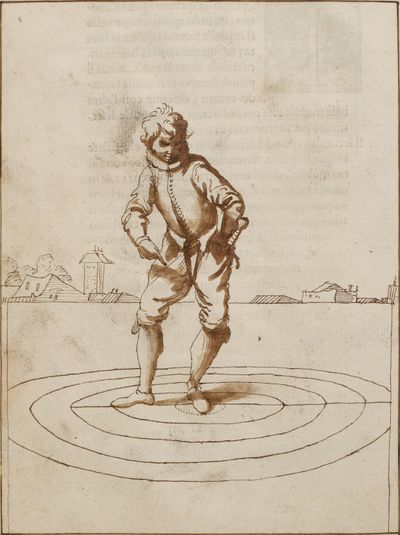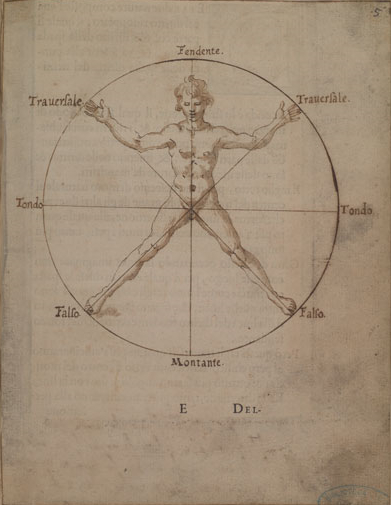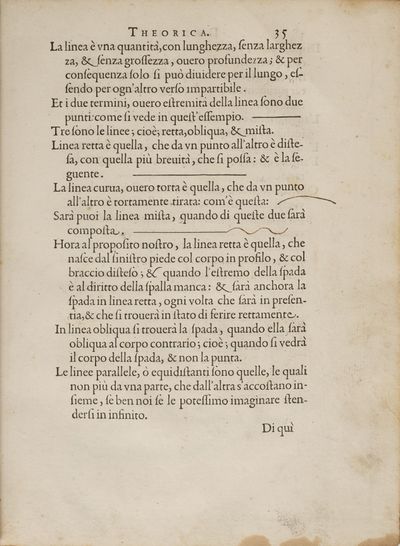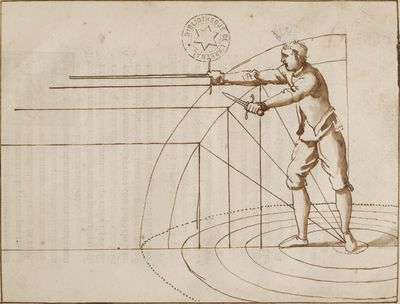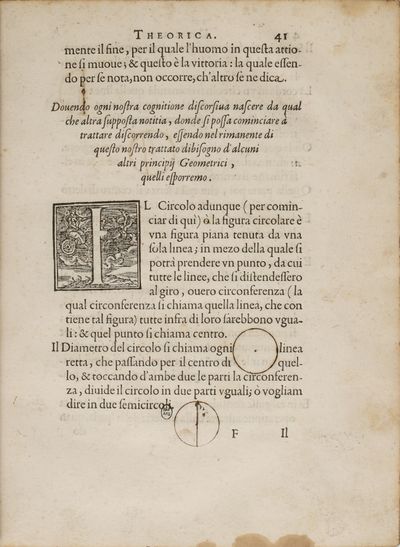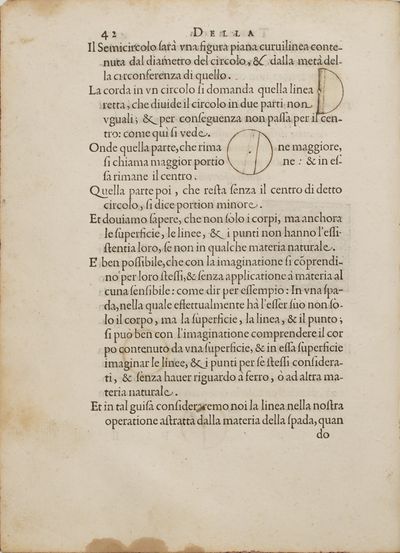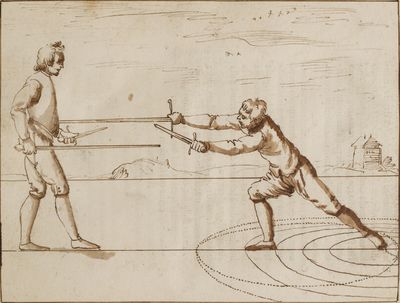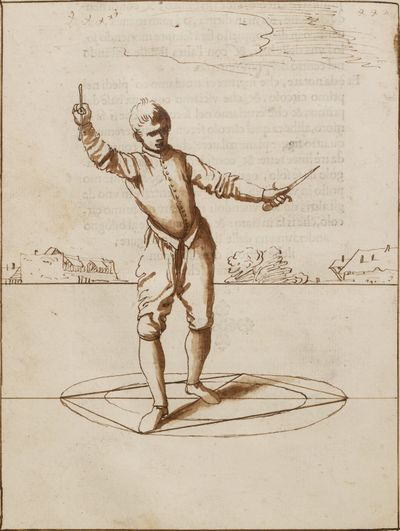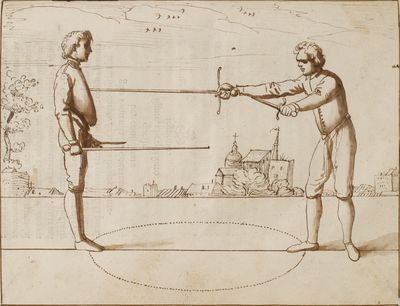|
|
You are not currently logged in. Are you accessing the unsecure (http) portal? Click here to switch to the secure portal. |
Difference between revisions of "Federico Ghisliero"
(→Temp) |
(→Temp) |
||
| Line 1,338: | Line 1,338: | ||
|- | |- | ||
| | | | ||
| − | | | + | | <p>''Since we have declared the seven circumstances which concur in the operation of arms, we must know that in order for an action of ours to be dependent on virtue, it must have four conditions; that is, that it be spontaneous, consulted, chosen and willed.''</p> |
| {{section|Page:Regole di molti cavagliereschi essercitii (Federico Ghisliero) 1587.pdf/73|1|lbl=59.1}} | | {{section|Page:Regole di molti cavagliereschi essercitii (Federico Ghisliero) 1587.pdf/73|1|lbl=59.1}} | ||
|- | |- | ||
| | | | ||
| − | | | + | | <p>'''S'''pontaneously done is understood to mean that we do it of our own free will; and conversely, those actions which we do not do of our own free will can be said not to be spontaneous.</p> |
| {{section|Page:Regole di molti cavagliereschi essercitii (Federico Ghisliero) 1587.pdf/73|2|lbl=59.2}} | | {{section|Page:Regole di molti cavagliereschi essercitii (Federico Ghisliero) 1587.pdf/73|2|lbl=59.2}} | ||
|- | |- | ||
| | | | ||
| − | | | + | | <p>From this it follows as a rule for us, that a man in the act of arms, will do all his actions voluntarily, being the first to make a firm commitment: and consequently he will act in such a way that his opponent will have to do everything against his will, forcing him to parry.</p> |
| {{section|Page:Regole di molti cavagliereschi essercitii (Federico Ghisliero) 1587.pdf/73|3|lbl=59.3}} | | {{section|Page:Regole di molti cavagliereschi essercitii (Federico Ghisliero) 1587.pdf/73|3|lbl=59.3}} | ||
|- | |- | ||
| | | | ||
| − | | | + | | <p>Consultation, as Aristotle determined, is about those things which can fall under human counsel.</p> |
| {{section|Page:Regole di molti cavagliereschi essercitii (Federico Ghisliero) 1587.pdf/73|4|lbl=59.4}} | | {{section|Page:Regole di molti cavagliereschi essercitii (Federico Ghisliero) 1587.pdf/73|4|lbl=59.4}} | ||
|- | |- | ||
| | | | ||
| + | | <p>Therefore, in this art of ours, we will well consult all the means that can lead us to our goal, which is victory.</p> | ||
| + | | {{section|Page:Regole di molti cavagliereschi essercitii (Federico Ghisliero) 1587.pdf/73|5|lbl=59.5}} | ||
| + | |||
| + | |- | ||
| | | | ||
| − | | | + | | <p>Election [choice or discrimination] is nothing other than a consent or assent to those things which are placed within us: for since a thing is first consulted and then elected, if it is first consulted and then judged, it will reasonably be elected.</p> |
| − | + | | {{section|Page:Regole di molti cavagliereschi essercitii (Federico Ghisliero) 1587.pdf/74|1|lbl=60.1}} | |
|- | |- | ||
| | | | ||
| − | | | + | | <p>So that from these two conditions, which I have joined together, we shall constitute a rule, that after having consulted the means of offense +& defense, we shall choose the best proportion of injury and defense, and that we shall continually operate.</p> |
| {{section|Page:Regole di molti cavagliereschi essercitii (Federico Ghisliero) 1587.pdf/74|2|lbl=60.2}} | | {{section|Page:Regole di molti cavagliereschi essercitii (Federico Ghisliero) 1587.pdf/74|2|lbl=60.2}} | ||
|- | |- | ||
| | | | ||
| − | | | + | | <p>Our will is ready to have regard to that end, which is not only truly good, but also apparent: for the acquisition of which we must then spontaneously within ourselves consult the means, which can lead us to it; and those, finally, choosing virtuously to operate; as we shall do in the battle of arms, which is fought from hand to hand. If, having regard to the true good, which in this action is to defend oneself and to offend the enemy, we shall consult and choose those things which we will animously put into execution, which otherwise will annul the whole art of arms. </p> |
| {{section|Page:Regole di molti cavagliereschi essercitii (Federico Ghisliero) 1587.pdf/74|3|lbl=60.3}} | | {{section|Page:Regole di molti cavagliereschi essercitii (Federico Ghisliero) 1587.pdf/74|3|lbl=60.3}} | ||
|- | |- | ||
| − | | | + | | [[File:Ghisliero 10.jpg|400px|center]] |
| − | | | + | | <p>And since from one point to another there is nothing but a straight line, and since one line is in the subject, the other cannot enter it, since two bodies cannot be in the same space at the same time, it remains that each time that two men come to combat each other, there will necessarily arise a circle of distance: which, starting from its diameter, and each of them forming a point, the one who first puts his sword into the diameter, which consequently becomes the straight line, will force the other to pass through it, so that he will have the offense as well as the defense, since the enemy’s sword will be parallel to his body. And so that this may be better understood, these figures, which follow below, should be well considered.</p> |
| | | | ||
{{section|Page:Regole di molti cavagliereschi essercitii (Federico Ghisliero) 1587.pdf/74|4|lbl=60.4|p=1}} {{pagetb|Page:Regole di molti cavagliereschi essercitii (Federico Ghisliero) 1587.pdf|75|lbl=61|p=1}} | {{section|Page:Regole di molti cavagliereschi essercitii (Federico Ghisliero) 1587.pdf/74|4|lbl=60.4|p=1}} {{pagetb|Page:Regole di molti cavagliereschi essercitii (Federico Ghisliero) 1587.pdf|75|lbl=61|p=1}} | ||
| Line 1,380: | Line 1,384: | ||
|- | |- | ||
| | | | ||
| − | | | + | | <p>The knowledge of arms being based on this, it has come to pass that the operations of those who have so far dealt with this matter have been various: they have either placed themselves in it, or else they have given the place, so that by parrying the enemy they might at the same time secure themselves by parrying; and by putting their sword in a straight line they might attack.</p> |
| {{section|Page:Regole di molti cavagliereschi essercitii (Federico Ghisliero) 1587.pdf/77|1|lbl=63.1}} | | {{section|Page:Regole di molti cavagliereschi essercitii (Federico Ghisliero) 1587.pdf/77|1|lbl=63.1}} | ||
|- | |- | ||
| | | | ||
| − | | | + | | <p>Those who have put their sword forward in a straight line have done so for the aforesaid reason, which is most important; and to keep themselves covered by the sword; and to keep the enemy at a distance: hence there are so, so many ways of gaining it.<ref>This is an important note; the sword is extended and the fencer is covered by the extension of the sword in a straight line. [note from Henry Fox]</ref></p> |
| {{section|Page:Regole di molti cavagliereschi essercitii (Federico Ghisliero) 1587.pdf/77|2|lbl=63.2}} | | {{section|Page:Regole di molti cavagliereschi essercitii (Federico Ghisliero) 1587.pdf/77|2|lbl=63.2}} | ||
|- | |- | ||
| | | | ||
| − | | | + | | <p>And the first, as is the custom in Spain and Italy, is to gain it by dividing the sword into three parts: of which the first, towards the fist, is the ''forte'',<ref>Strongest third of the blade from the hilt toward the middle.</ref> because it is closer to the moving power: and the last is ''debole'',<ref>Strongest third of the blade from the hilt toward the middle.</ref> because it is far from the moving power: but while it is weak in parrying it is very strong in attacking.</p> |
| {{section|Page:Regole di molti cavagliereschi essercitii (Federico Ghisliero) 1587.pdf/77|3|lbl=63.3}} | | {{section|Page:Regole di molti cavagliereschi essercitii (Federico Ghisliero) 1587.pdf/77|3|lbl=63.3}} | ||
|- | |- | ||
| | | | ||
| − | | | + | | <p>Proceeding in this way, one must have placed his sword above that of the enemy in the ''debole'',<ref>Note the positions of the weapons relative to one another. This is consistent with the Aristotelian and the Iberian approaches. [note |
| + | from Henry Fox]</ref> keeping his arm gathered, and the fist of his hand placed on the level, or rather a little lower than that of the enemy.<ref>The position of the hand and blade position in this initial stage is vital to the techniques that will follow. [note from Henry Fox]</ref> In such a way that, while waiting for the other hand to release it, at the same time one gains a straight line by extending the arm. As a rule, one should keep in mind that one should go to the sword at one moment, and at the enemy body at another.<ref>This appears to be discussing taking the line or ''stringeri''.</ref></p> | ||
| | | | ||
{{section|Page:Regole di molti cavagliereschi essercitii (Federico Ghisliero) 1587.pdf/77|4|lbl=63.4|p=1}} {{section|Page:Regole di molti cavagliereschi essercitii (Federico Ghisliero) 1587.pdf/78|1|lbl=64.1|p=1}} | {{section|Page:Regole di molti cavagliereschi essercitii (Federico Ghisliero) 1587.pdf/77|4|lbl=63.4|p=1}} {{section|Page:Regole di molti cavagliereschi essercitii (Federico Ghisliero) 1587.pdf/78|1|lbl=64.1|p=1}} | ||
| Line 1,401: | Line 1,406: | ||
|- | |- | ||
| | | | ||
| − | | | + | | <p>In defense of this, which I have said, it was customary at the time when the sword was in motion, in order to overcome it, to stop it in said motion, and to free the sword,</p> |
| + | * by making a motion with the sword alone, or | ||
| + | * by using the disengaged joust, which is to carry the body from one leg to the other; or | ||
| + | * by withdrawing the left foot behind: and in this way proceeding from hand to hand, one against the other. | ||
| + | <p>But this is more likely to be used as a feint than as a real attack: since men are unequal in size and strength, just as swords are unequal in length and weight, an altered man is unable to discern the minutiae of the game; and since this game is founded on uncertain principles, it will also be uncertain.</p> | ||
| {{section|Page:Regole di molti cavagliereschi essercitii (Federico Ghisliero) 1587.pdf/78|2|lbl=64.2}} | | {{section|Page:Regole di molti cavagliereschi essercitii (Federico Ghisliero) 1587.pdf/78|2|lbl=64.2}} | ||
|- | |- | ||
| | | | ||
| − | | | + | | <p>Some of them prevent many of these inconveniences by finding themselves in said line with their swords; when the enemy goes to square them, at that time they carry their swords outside the straight line. When they meet the enemy’s sword out of the straight line, and then, by placing their shoulder on the wall, without separating their sword from the enemy’s, they cross the line with their foot and strike with a ''punta riversa''.<ref>A “reversed thrust” in this instance.</ref></p> |
| {{section|Page:Regole di molti cavagliereschi essercitii (Federico Ghisliero) 1587.pdf/78|3|lbl=64.3}} | | {{section|Page:Regole di molti cavagliereschi essercitii (Federico Ghisliero) 1587.pdf/78|3|lbl=64.3}} | ||
|- | |- | ||
| | | | ||
| − | | | + | | <p>Many of them, having considered that while they were gaining the weakness of the enemy’s sword, they could be attacked at the same time. In drawing their sword from the enemy, kept this order in going to the enemy’s sword, to bring the body towards it, so that if the enemy freed his sword, and attacked, he would find no place to attack: so that in that movement they put their sword into the attack in a straight line.</p> |
| {{section|Page:Regole di molti cavagliereschi essercitii (Federico Ghisliero) 1587.pdf/79|1|lbl=65.1}} | | {{section|Page:Regole di molti cavagliereschi essercitii (Federico Ghisliero) 1587.pdf/79|1|lbl=65.1}} | ||
|- | |- | ||
| | | | ||
| − | | | + | | <p>But when the enemy’s sword had been raised high, they gave the same opportunity to the enemy, so that he might be attacked. And this they did with certain cuts of the sword with the weapon accompanied, and united, with the same movement of the body with the right hand, or with the left hand; and attacking the enemy they at that time either bound the enemy’s sword with a ''molinello'', and attacked with the dagger; or attacked by putting at that tempo of his sword in a straight line.</p> |
| {{section|Page:Regole di molti cavagliereschi essercitii (Federico Ghisliero) 1587.pdf/79|2|lbl=65.2}} | | {{section|Page:Regole di molti cavagliereschi essercitii (Federico Ghisliero) 1587.pdf/79|2|lbl=65.2}} | ||
|- | |- | ||
| | | | ||
| − | | | + | | <p>It has also been customary, in order to distract this straight line from its posture, to make feints, either from inside, or from outside with points, or with cuts, in order to frighten that person, who finds himself with his sword ''in presentia'':<ref>‘''in presentia''’ means the sword is on the line of engagement. [Note by Táriq ibn Jelal ibn Ziyadatallah al-Naysábúrí]</ref> so that, coming out of the line with his sword to parry, you would give him a place where he could put his sword into the enemy’s hand. But these people who make these feints first make a mistake in order to make the enemy make another one: which mistakes are then paid for by the loss of life.</p> |
| | | | ||
{{section|Page:Regole di molti cavagliereschi essercitii (Federico Ghisliero) 1587.pdf/79|3|lbl=65.3|p=1}} {{section|Page:Regole di molti cavagliereschi essercitii (Federico Ghisliero) 1587.pdf/80|1|lbl=66.1|p=1}} | {{section|Page:Regole di molti cavagliereschi essercitii (Federico Ghisliero) 1587.pdf/79|3|lbl=65.3|p=1}} {{section|Page:Regole di molti cavagliereschi essercitii (Federico Ghisliero) 1587.pdf/80|1|lbl=66.1|p=1}} | ||
| Line 1,427: | Line 1,436: | ||
|- | |- | ||
| | | | ||
| − | | | + | | <p>And because he who finds himself in this posture, with every little movement will always maintain the said advantage, if he will always keep the point of his sword fixed in the right shoulder of the enemy; and wherever he will go he will follow it with the said vain hope. Hence many imagined not to retreat from that sword, pressing its weak point, but to overshadow it with their own; and so that they might have some distance to attack, they did so with the short foot in front: and they had to put their foot on the right side of the enemy’s foot, and the sword extended in a straight line to the level of the enemy; and having arrived at a distance, and with the right foot, increasing their wound.<ref>This explains the advantages of Ghisliero’s guard position, demonstrating that the guard is the foundation of a fencing system. [note by Henry Fox]</ref></p> |
| {{section|Page:Regole di molti cavagliereschi essercitii (Federico Ghisliero) 1587.pdf/80|2|lbl=66.2}} | | {{section|Page:Regole di molti cavagliereschi essercitii (Federico Ghisliero) 1587.pdf/80|2|lbl=66.2}} | ||
|- | |- | ||
| | | | ||
| − | | | + | | <p>However, if he places himself in this line, if he makes a single movement with his right foot, he will injure the enemy: because when he is pursued by the enemy, he can be attacked by the ''punta scavizzata''<ref>''Punta scavizzata'' means hollow point.</ref> as it is called by these fencing masters, or by the ''gobba'';<ref>''Gobba'' means hump or hunchback.</ref> and when we provoke him from within, he can be attacked by the ''punta riversa'',<ref>''Puinta riversa'' is a spelling variation from ''punta riversa''.</ref> or by the ''incapocchiato''.<ref>''Incapocchiato'' does not translate, it suggests the word incapacitate. ''Incapocchiársi'' means ‘to become a doult or logger-head, to take a foolish conceite’ (Florio 1611) It might also mean encompassing in modern Italian.</ref></p> |
| {{section|Page:Regole di molti cavagliereschi essercitii (Federico Ghisliero) 1587.pdf/80|3|lbl=66.3}} | | {{section|Page:Regole di molti cavagliereschi essercitii (Federico Ghisliero) 1587.pdf/80|3|lbl=66.3}} | ||
|- | |- | ||
| | | | ||
| − | | | + | | <p>Others have based their actions on offense and defense, and have proceeded in various ways; or while the enemy is on guard, they have tried to make a strong blow with a cut, or a thrust, in order to provoke the enemy; so that by disconcerting themselves with the parry, or with the attack, they can parry and then attack.</p> |
| | | | ||
{{section|Page:Regole di molti cavagliereschi essercitii (Federico Ghisliero) 1587.pdf/80|4|lbl=66.4|p=1}} {{section|Page:Regole di molti cavagliereschi essercitii (Federico Ghisliero) 1587.pdf/81|1|lbl=67.1|p=1}} | {{section|Page:Regole di molti cavagliereschi essercitii (Federico Ghisliero) 1587.pdf/80|4|lbl=66.4|p=1}} {{section|Page:Regole di molti cavagliereschi essercitii (Federico Ghisliero) 1587.pdf/81|1|lbl=67.1|p=1}} | ||
| Line 1,443: | Line 1,452: | ||
|- | |- | ||
| | | | ||
| − | | | + | | <p>That is to say, when they found the sword present, they disconcerted it, either by beating it in its weakness with the true edge at the bottom, or with the false edge from the bottom upwards: so that they could attack at that time: in which way the parries, and attacks are reduced indefinitely: as can be seen in the books which have dealt with this.</p> |
| {{section|Page:Regole di molti cavagliereschi essercitii (Federico Ghisliero) 1587.pdf/81|2|lbl=67.2}} | | {{section|Page:Regole di molti cavagliereschi essercitii (Federico Ghisliero) 1587.pdf/81|2|lbl=67.2}} | ||
|- | |- | ||
| | | | ||
| − | | | + | | <p>Those who give an uncovered place do so in order to give the enemy an opportunity to attack, so that he may parry and attack; but the feints do great harm to them, and beyond that the same method is reduced indefinitely.</p> |
| {{section|Page:Regole di molti cavagliereschi essercitii (Federico Ghisliero) 1587.pdf/81|3|lbl=67.3}} | | {{section|Page:Regole di molti cavagliereschi essercitii (Federico Ghisliero) 1587.pdf/81|3|lbl=67.3}} | ||
|- | |- | ||
| | | | ||
| − | | | + | | <p>But we, in order not to incur in these kinds of offences and defences, will not take care to put our sword in a straight line, nor, since there is that of the enemy, will we attempt to draw it in the said terms: on the contrary, we will act according to due reason. And because true science consists in knowing the causes of things; which, once known and removed, the effect is also removed, we shall consider the cause of such a line; which is the point of the enemy’s shoulder, and the point of our body at which the line is aimed: and each time the point of the line is removed from the extremity of our body, the effect of the line is consequently removed.</p> |
| | | | ||
{{section|Page:Regole di molti cavagliereschi essercitii (Federico Ghisliero) 1587.pdf/81|4|lbl=67.4|p=1}} {{section|Page:Regole di molti cavagliereschi essercitii (Federico Ghisliero) 1587.pdf/82|1|lbl=68.1|p=1}} | {{section|Page:Regole di molti cavagliereschi essercitii (Federico Ghisliero) 1587.pdf/81|4|lbl=67.4|p=1}} {{section|Page:Regole di molti cavagliereschi essercitii (Federico Ghisliero) 1587.pdf/82|1|lbl=68.1|p=1}} | ||
| Line 1,459: | Line 1,468: | ||
|- | |- | ||
| | | | ||
| − | | | + | | <p>And this point can be recovered in two ways:</p> |
| + | * in the first, by not losing ground; and with the transversal path by going out or to the left; | ||
| + | * in the other, when ground is lost by retreating a step, and by striking the same point. | ||
| {{section|Page:Regole di molti cavagliereschi essercitii (Federico Ghisliero) 1587.pdf/82|2|lbl=68.2}} | | {{section|Page:Regole di molti cavagliereschi essercitii (Federico Ghisliero) 1587.pdf/82|2|lbl=68.2}} | ||
|- | |- | ||
| | | | ||
| − | | | + | | <p>To take the point out of the straight line is done in this way; that is to say, having divided the body into two parts equal to the diameter of our circle, in each part we constitute a point; and of our own free will we place one of them at the extremity of the line; or the enemy is the one who places his sword in one of them. And when of our own free we place it, it will always be the right one, in order to make the attack easier and more comfortable: because in this way we will gain a certain amount of ground.</p> |
| {{section|Page:Regole di molti cavagliereschi essercitii (Federico Ghisliero) 1587.pdf/82|3|lbl=68.3}} | | {{section|Page:Regole di molti cavagliereschi essercitii (Federico Ghisliero) 1587.pdf/82|3|lbl=68.3}} | ||
|- | |- | ||
| | | | ||
| − | | | + | | <p>When the enemy is the one who puts his sword into one of our two points, if by chance he puts it on the right side, we shall come out with the left foot; if on the left side, we shall come out with the right foot, so that by doing so we remove the effect of the enemy’s line.</p> |
| {{section|Page:Regole di molti cavagliereschi essercitii (Federico Ghisliero) 1587.pdf/82|4|lbl=68.4}} | | {{section|Page:Regole di molti cavagliereschi essercitii (Federico Ghisliero) 1587.pdf/82|4|lbl=68.4}} | ||
|- | |- | ||
| | | | ||
| − | | | + | | <p>In addition to annulling the enemy’s line, the re-movement of the forearm creates for us another line, in which, by drawing our sword, we can attack; and in this way our body salutes us, which, by running away from the first attacks...</p> |
| | | | ||
{{section|Page:Regole di molti cavagliereschi essercitii (Federico Ghisliero) 1587.pdf/82|5|lbl=68.5|p=1}} {{section|Page:Regole di molti cavagliereschi essercitii (Federico Ghisliero) 1587.pdf/83|1|lbl=69.1|p=1}} | {{section|Page:Regole di molti cavagliereschi essercitii (Federico Ghisliero) 1587.pdf/82|5|lbl=68.5|p=1}} {{section|Page:Regole di molti cavagliereschi essercitii (Federico Ghisliero) 1587.pdf/83|1|lbl=69.1|p=1}} | ||
| Line 1,480: | Line 1,491: | ||
|- | |- | ||
| | | | ||
| − | | | + | | <p>...on our straight sides, will then withdraw them with a step backwards; and at the same time we will attack his arm: but attacking it on our left side, we will lose the ground with our left foot, and at that time we will attack. But we do not make use of this method, since we could operate in a better way.</p> |
| {{section|Page:Regole di molti cavagliereschi essercitii (Federico Ghisliero) 1587.pdf/83|2|lbl=69.2}} | | {{section|Page:Regole di molti cavagliereschi essercitii (Federico Ghisliero) 1587.pdf/83|2|lbl=69.2}} | ||
|- | |- | ||
| | | | ||
| − | | | + | | <p>And since every kind of cause and every kind of object can be considered at times to be in the power of production, and at other times to be in action, so we will consider that line to be in action when it will not be there, but it will be capable of coming to us, since all lines in whatever kind of position they may be, are attacked in a straight line, as can be seen in these figures which follow.</p> |
| {{section|Page:Regole di molti cavagliereschi essercitii (Federico Ghisliero) 1587.pdf/83|3|lbl=69.3}} | | {{section|Page:Regole di molti cavagliereschi essercitii (Federico Ghisliero) 1587.pdf/83|3|lbl=69.3}} | ||
|- | |- | ||
| | | | ||
| − | | | + | | <p>We will distinguish, therefore, that our opponent will either be in one of two states, that is, at rest, or if he departs from that state, he will be in motion.</p> |
| {{section|Page:Regole di molti cavagliereschi essercitii (Federico Ghisliero) 1587.pdf/85|1|lbl=71.1}} | | {{section|Page:Regole di molti cavagliereschi essercitii (Federico Ghisliero) 1587.pdf/85|1|lbl=71.1}} | ||
|- | |- | ||
| | | | ||
| − | | | + | | <p>While he is at rest, he will keep his sword in a straight line (that is, he will bring it forth) or, having it outside the said line, he will keep it in force [power, strength] to be ready to put it in said line.</p> |
| {{section|Page:Regole di molti cavagliereschi essercitii (Federico Ghisliero) 1587.pdf/85|2|lbl=71.2}} | | {{section|Page:Regole di molti cavagliereschi essercitii (Federico Ghisliero) 1587.pdf/85|2|lbl=71.2}} | ||
|- | |- | ||
| | | | ||
| − | | | + | | <p>When he holds the sword in production (that is, in the straight line) we must consider that, in accordance with the opening of his compasses, the sword will come to the point of the straight shoulder, and consequently the point of our surface will be on the right side of that line: this line will always be called straight, until it reaches the right side of the center of our body.</p> |
| {{section|Page:Regole di molti cavagliereschi essercitii (Federico Ghisliero) 1587.pdf/85|3|lbl=71.3}} | | {{section|Page:Regole di molti cavagliereschi essercitii (Federico Ghisliero) 1587.pdf/85|3|lbl=71.3}} | ||
|- | |- | ||
| | | | ||
| − | | | + | | <p>While our enemy holds his sword in power to put it in a straight line, it will be called an oblique line; which will either be in front (that is, in the presence) or behind (outside the presence).</p> |
| {{section|Page:Regole di molti cavagliereschi essercitii (Federico Ghisliero) 1587.pdf/85|4|lbl=71.4}} | | {{section|Page:Regole di molti cavagliereschi essercitii (Federico Ghisliero) 1587.pdf/85|4|lbl=71.4}} | ||
|- | |- | ||
| | | | ||
| − | | | + | | <p>The sword will be said to be oblique in presence in three ways:</p> |
| + | * In the first, when it is present in the diameter of our circle, but then lies below the center of our body. | ||
| + | * In the second, the enemy sword will be said to be oblique to our body when both are within the diameter of the circle of distance; and the point of the enemy sword will be outside our body, either high, low, or in whatever kind of proportion we wish: this will be the case when we hold the sword’s fist against its fingers or hands. | ||
| + | * In the third, the opposite sword is oblique to our body, while it forms an angle with the arm, and the point of the sword exceeds the center of our body. | ||
| | | | ||
{{section|Page:Regole di molti cavagliereschi essercitii (Federico Ghisliero) 1587.pdf/85|5|lbl=71.5|p=1}} {{section|Page:Regole di molti cavagliereschi essercitii (Federico Ghisliero) 1587.pdf/86|1|lbl=72.1|p=1}} | {{section|Page:Regole di molti cavagliereschi essercitii (Federico Ghisliero) 1587.pdf/85|5|lbl=71.5|p=1}} {{section|Page:Regole di molti cavagliereschi essercitii (Federico Ghisliero) 1587.pdf/86|1|lbl=72.1|p=1}} | ||
| Line 1,516: | Line 1,530: | ||
|- | |- | ||
| | | | ||
| − | | | + | | <p>Outside the present, or behind, the enemy can hold his sword in two ways: either with his right foot forward, or with his left foot. With his right foot he will hold it either low and collected, or high and in the act of striking a blow. When he holds it with his left foot forward, he will either hold it high in a ''guardia di falcone'',<ref>''Guardia di falcone'' means "falcon’s guard". This is what the Bolognese authors call ''guardia alta''. [Note by Táriq ibn Jelal ibn Ziyadatallah al-Naysábúrí]</ref> or low in a guard called by many ''coda lunga e larga''.<ref>''Coda longa, & larga'' or ''coda lunga e larga'' means "long and broad tail guard".</ref></p> |
| {{section|Page:Regole di molti cavagliereschi essercitii (Federico Ghisliero) 1587.pdf/86|2|lbl=72.2}} | | {{section|Page:Regole di molti cavagliereschi essercitii (Federico Ghisliero) 1587.pdf/86|2|lbl=72.2}} | ||
|- | |- | ||
| | | | ||
| − | | | + | | <p>And all these lines can be placed in an infinite number of proportions: and therefore it has come about that so many guards have been formed, because from all the principles of the attacks, from all their means, and from all their ends, postures can be formed. But so that we may not be confused, we shall refer only to these proportions, which we have said, in which the enemy will necessarily find himself: it doesn’t much matter whether they are a little higher or a little lower.</p> |
| {{section|Page:Regole di molti cavagliereschi essercitii (Federico Ghisliero) 1587.pdf/86|3|lbl=72.3}} | | {{section|Page:Regole di molti cavagliereschi essercitii (Federico Ghisliero) 1587.pdf/86|3|lbl=72.3}} | ||
|- | |- | ||
| | | | ||
| − | | | + | | <p>Returning now to the declaration of our art, I say that when the enemy finds himself in any kind of tranquillity in his posture, we must, in order to operate with knowledge, consider the four causes which cause the effects: first of all, the efficient cause, which is man; and this is the most general and remote cause in the action of this posture; but the most propitious and particular will be the act in which man finds himself; and this act shows us the effect which can arise from it.</p> |
| {{section|Page:Regole di molti cavagliereschi essercitii (Federico Ghisliero) 1587.pdf/87|1|lbl=73.1}} | | {{section|Page:Regole di molti cavagliereschi essercitii (Federico Ghisliero) 1587.pdf/87|1|lbl=73.1}} | ||
|- | |- | ||
| | | | ||
| − | | | + | | <p>The formal cause, which is motion in general from its stillness, denotes to us the measure of the particular motion, which is to bring it into effect.</p> |
| {{section|Page:Regole di molti cavagliereschi essercitii (Federico Ghisliero) 1587.pdf/87|2|lbl=73.2}} | | {{section|Page:Regole di molti cavagliereschi essercitii (Federico Ghisliero) 1587.pdf/87|2|lbl=73.2}} | ||
|- | |- | ||
| | | | ||
| − | | | + | | <p>The formal cause, which is the proportion of the enemy sword, reveals to us the effect of its attack.</p> |
| {{section|Page:Regole di molti cavagliereschi essercitii (Federico Ghisliero) 1587.pdf/87|3|lbl=73.3}} | | {{section|Page:Regole di molti cavagliereschi essercitii (Federico Ghisliero) 1587.pdf/87|3|lbl=73.3}} | ||
|- | |- | ||
| | | | ||
| − | | | + | | <p>I want the final cause to be the one that we consider in this effect around the line of the sword, which in attacking has the purpose of striking our body. But the final cause will be the point on our surface.</p> |
| {{section|Page:Regole di molti cavagliereschi essercitii (Federico Ghisliero) 1587.pdf/87|4|lbl=73.4}} | | {{section|Page:Regole di molti cavagliereschi essercitii (Federico Ghisliero) 1587.pdf/87|4|lbl=73.4}} | ||
|- | |- | ||
| | | | ||
| − | | | + | | <p>And if the enemy finds himself with his sword in a straight line, but subjected to our dagger, as if he were on guard three and four, then, beating that line, and at the same time attacking, we will put our sword in a straight line: but with the sword alone we will come out with the short foot, attacking.</p> |
| | | | ||
{{section|Page:Regole di molti cavagliereschi essercitii (Federico Ghisliero) 1587.pdf/87|5|lbl=73.5|p=1}} {{section|Page:Regole di molti cavagliereschi essercitii (Federico Ghisliero) 1587.pdf/88|1|lbl=74.1|p=1}} | {{section|Page:Regole di molti cavagliereschi essercitii (Federico Ghisliero) 1587.pdf/87|5|lbl=73.5|p=1}} {{section|Page:Regole di molti cavagliereschi essercitii (Federico Ghisliero) 1587.pdf/88|1|lbl=74.1|p=1}} | ||
| Line 1,552: | Line 1,566: | ||
|- | |- | ||
| | | | ||
| − | | | + | | <p>While the enemy will hold his sword against us in a straight line, in a state of straight foot, or short foot in front, as in guarding the head, or in front of the face, or with the right foot in front of the head in a first and second guard, we will keep as a rule the rule of going out of that straight foot with transversal movement.</p> |
| {{section|Page:Regole di molti cavagliereschi essercitii (Federico Ghisliero) 1587.pdf/88|2|lbl=74.2}} | | {{section|Page:Regole di molti cavagliereschi essercitii (Federico Ghisliero) 1587.pdf/88|2|lbl=74.2}} | ||
|- | |- | ||
| | | | ||
| − | | | + | | <p>When the enemy’s sword is oblique to our body, that is to say, in its first position under the center of our body, we must strike with our left foot in the same position, in order to ''scanso del corpo'',<ref>scanso del corpo means void the body. Basically, these are the body turns we use to take the body off the line of engagement. [Note by Táriq ibn Jelal ibn Ziyadatallah al-Naysábúrí]</ref> and here I am speaking only of the sword, because if we have the dagger, we will place it in the imagined line, and we will strike in our usual manner.</p> |
| {{section|Page:Regole di molti cavagliereschi essercitii (Federico Ghisliero) 1587.pdf/88|3|lbl=74.3}} | | {{section|Page:Regole di molti cavagliereschi essercitii (Federico Ghisliero) 1587.pdf/88|3|lbl=74.3}} | ||
|- | |- | ||
| | | | ||
| − | | | + | | <p>If the enemy’s sword is oblique to our body in the second way (in this case we will see the body of the sword and not its point) we will always gain on our right hand, and escaping that length, and attacking, we will place our sword on the diagonal.</p> |
| {{section|Page:Regole di molti cavagliereschi essercitii (Federico Ghisliero) 1587.pdf/88|4|lbl=74.4}} | | {{section|Page:Regole di molti cavagliereschi essercitii (Federico Ghisliero) 1587.pdf/88|4|lbl=74.4}} | ||
|- | |- | ||
| | | | ||
| − | | | + | | <p>But if the sword is oblique in the third way, we must distinguish that if the point of the angular line is at the right of our straight point, then we will act against it as if it were in a straight line; but if it were with the tip of the sword in the chest at our short point, we will cut it off, driving our sword in a straight line into the wound.</p> |
| | | | ||
{{section|Page:Regole di molti cavagliereschi essercitii (Federico Ghisliero) 1587.pdf/88|5|lbl=74.5|p=1}} {{section|Page:Regole di molti cavagliereschi essercitii (Federico Ghisliero) 1587.pdf/89|1|lbl=75.1|p=1}} | {{section|Page:Regole di molti cavagliereschi essercitii (Federico Ghisliero) 1587.pdf/88|5|lbl=74.5|p=1}} {{section|Page:Regole di molti cavagliereschi essercitii (Federico Ghisliero) 1587.pdf/89|1|lbl=75.1|p=1}} | ||
| Line 1,573: | Line 1,587: | ||
|- | |- | ||
| | | | ||
| − | | | + | | <p>In the event that our opponent should hold his sword backwards, or in a fury of presence, with his foot straight forward, as some do when they hold their swords together in order to make the ''inquartata'':<ref>''Inquartata'' means quartering step. It is a voiding action of the body which closes the inside line.</ref> or when they are in ''guardia alta in coda lunga e larga''; or with their foot short forward in a ''guardia di falcone''; or in a ''coda lunga'';<ref>“Long and high tail” guard.</ref> And even if it is finally in any kind of proportion, even if it is out of the present; we will always take care to fight with the body; and we will try to move it with our straight sides, since it is (as Aristotle says) natural to all animals.</p> |
| {{section|Page:Regole di molti cavagliereschi essercitii (Federico Ghisliero) 1587.pdf/89|2|lbl=75.2}} | | {{section|Page:Regole di molti cavagliereschi essercitii (Federico Ghisliero) 1587.pdf/89|2|lbl=75.2}} | ||
Revision as of 04:30, 21 March 2024
| Federico Ghisliero | |
|---|---|
| Died | 1619 Turin, Italy |
| Occupation |
|
| Nationality | Italian |
| Genres | Fencing manual |
| Language | Italian |
| Notable work(s) | Regole di molti cavagliereschi essercitii (1587) |
Federico Ghisliero was a Bolognese soldier and fencer. Little is know about his early life, but he studied fencing under the famous Silvio Piccolomini.
In 1587, he published a fencing treatise called Regole di molti cavagliereschi essercitii, dedicated to Ranuccio Farnese, who was 18 years old at the time of publication and would become Duke of Parma, Piacenza, and Castro. Ghisliero's manual is notable for his use of geometry in relation to fencing, and the incredibly detailed illustrations, using concentric circles centered on where the fencer has placed most of their weight (often, but not always, the back foot), and illustrating multiple versions of each figure in a plate, showing the progression of the movements he describes.
Treatise
Temp
Images |
Transcription | |
|---|---|---|
For further information, including transcription and translation notes, see the discussion page.
| Work | Author(s) | Source | License |
|---|---|---|---|
| Images | Bibliothèque nationale de France | ||
| Translation | Nicola Boyd | Rules of many knightly armies | |
| Transcription | Nicola Boyd | Index:Regole di molti cavagliereschi essercitii (Federico Ghisliero) |
Additional Resources
The following is a list of publications containing scans, transcriptions, and translations relevant to this article, as well as published peer-reviewed research.
- Anglo, Sydney (1994). "Sixteenth-century Italian drawings in Federico Ghisliero's Regole di molti cavagliereschi essercitii." Apollo 140(393): 29-36.
- Gotti, Roberto (2023). "The Dynamic Sphere: Thesis on the Third State of the Vitruvian Man." Martial Culture and Historical Martial Arts in Europe and Asia: 93-147. Ed. by Daniel Jaquet; Hing Chao; Loretta Kim. Springer.
References
- ↑ 1.0 1.1 Cavagliereschi is Corsican for "chivalrous", while the Italian is "knightly".
- ↑ La gratia is Catalan for "grace".
- ↑ Ghisliero is telling his reader that he is a soldier not a civilian swordsman, so it will have a different perspective to others, hence his later comments on siege craft. [note from Henry Fox]
- ↑ This and the previous paragraph are commending the work to the patron, justifying the work’s existence and its purpose, common in treatises of the period. [note from Henry Fox]
- ↑ It was common to refer to “ancients” in the justification of the art of swordsmanship. [note from Henry Fox]
- ↑ When ‘this art’ or ‘the art’ is referenced it means the art of fencing. [More expansively the ars militari (military arts) or for the more classical, the Arts of Mars, of which swordsmanship falls within.] [note from Henry Fox]
- ↑ Further justification by demonstration of the benefits to those who practice the art in question, also common, especially referring to defense of the person and the realm. [note from Henry Fox]
- ↑ The version dedicated to Antonino instead reads "...for the instruction of the Most Illustrious Lord Antonio Pio Bonello".
- ↑ Cavalier – cavaliere – knights – so indicating the noble nature of the art which he is presenting. [note from Henry Fox]
- ↑ The Humours.
- ↑ Means sad.
- ↑ Means calm.
- ↑ Means optimistic.
- ↑ Means bad-tempered.
- ↑ Hot-tempered.
- ↑ Moti has a number of meanings in modern Italian aside from "motion", including "motorcycle, bike, watercraft, riot, scooter".
- ↑ The use of square brackets [] shows the insertion of the translator to aid in clarity of meaning throughout the document.
- ↑ Contextually, transportar is in modern Italian trasporto and has been translated such.
- ↑ Where the word operante which means the operator or the person taking action or more simply the will is used elsewhere, I translate it to fencer as operator has the wrong connotations in English for what Ghisliaro appears to wish to convey.
- ↑ This is an application of Aristotle’s Causes, in some ways more easily explained due to the application of the sword (though this could be my fencer’s brain), especially as it develops. Ghisliero uses seven rather than four as Aristotle does, or at least using the same method of explanation. [Henry Fox]
- ↑ The spelling of secóda is seconda in modern Italian. This shortening of words through the removal of ‘n’ is common in documents of the period.
- ↑ Public roads means the location is a public road.
- ↑ Of Vitruvius’ Ten Books on Architecture. [This same book is referenced in Thibault] [note from Henry Fox]
- ↑ Or capacity.
- ↑ Flavius Vegetius Renatus' On Roman Military Matters is likely the text to which he is referring. Which was a fourth century commentary on the training of Roman legions harking back to older methods. [note from Henry Fox]
- ↑ Onde is Catalan. It is dove in Italian. Both mean ‘where’ in English.
- ↑ A second century book written by a Roman in the Attica region which encompasses the city of Athens.
- ↑ Dodrans is a Latin contraction of de-quadrans which means “a whole unit less a quarter” or three-quarters.
- ↑ Referencing the ‘ancients’ for authority was commonly used by authors of the time to demonstrate their comprehensive knowledge of the subject. It is intended to add gravitas to the treatise.
- ↑ All’hora is Catalan. Modern Italian is al tempo.
- ↑ The Elder.
- ↑ Scriue is Catalan. Modern Italian is lui scrive.
- ↑ Scurzo, does not translate appropriately from Italian. As with a number of words in Ghisliero’s treatise, it is likely a Catalase word or a unique spelling. Analysis of other treaties such as Jarod Kirby’s Italian Rapier Combat (Kirby, 2004) shows the following two definitions, on page 14 of the text, of a similar sound word that is contextually a more likely approximation of what scurzo means; “Scanso, A voidance, any evasive manoeuvre that moves the body of the direct line” and “Scanso del pie dritto, A voidance made by moving the right foot slightly off the direct line while turning the body.” So for the purposes of this translation, scurzo will mean in this text the middle stance as shown in Figure 3, i.e. a partial voiding stance halfway between perspective and profile.
- ↑ "Perspective" means front facing forward.
- ↑ Also could be interpreted as "figure".
- ↑ George Silver’s theory of the time for the hand and foot from his 1599 text Paradoxes of Defense mirrors this framework. [note from Henry Fox] (Silver, 1599)
- ↑ Et is Latin for ‘and’ in English and e in Italian.
- ↑ This is not an exact translation – it is the best approximation based on context.
- ↑ Balancia translates into ‘balance’.
- ↑ Membro translates to ‘member’, but in English a better word is limb.
- ↑ ò á mano manca la fontanella directly translates to something like ‘the hand missing the fontanelle’. This made no contextual sense, so it has been translated to ‘from the fountain of the body’ as fonta can mean ‘source’ in modern Italian. In the it states that “Fontánella, a little fountaine. Also a fontanell or cauterie [something to cauterise wounds], or rowling [turning round about, whirling or turning round], used also for the chiefe vein of a man’s body.” (Florio, 1611)
- ↑ ‘Perspective’ is forward facing as can be seen in Figure 3.
- ↑ No good translation found, contextually translating spatio to ‘space’.
- ↑ Polykleitos's Doryphoros is an early example of this position called contrapposto. See https://en.wikipedia.org/wiki/Polykleitos for examples of sculptures with this stance. (Wikipeadia, 2021)
- ↑ Polykleitos wrote a lost treatise called ‘Artistic canons of body proportions’ in 5th Century Greece which provided a reference for standard body proportions. For more information https://en.wikipedia.org/wiki/Artistic_canons_of_body_proportions (Wikipeadia, 2021)
- ↑ The act or process of passing across, over, or through.
- ↑ Aristotle’s fifth book of the Physica, which considers how motion occurs. “Book V classifies four species of movement, depending on where the opposites are located. Movement categories include quantity (e.g. a change in dimensions, from great to small), quality (as for colours: from pale to dark), place (local movements generally go from up downwards and vice versa), or, more controversially, substance. In fact, substances do not have opposites, so it is inappropriate to say that something properly becomes, from not-man, man: generation and corruption are not kinesis in the full sense.” (Aristotle, Physica (Book 5), (384–322 BC) 2007) “Generally things which come to be, come to be in different ways: (1) by change of shape, as a statue; (2) by addition, as things which grow; (3) by taking away, as the Hermes from the stone; (4) by putting together, as a house; (5) by alteration, as things which ‘turn’ in respect of their material substance.” Book 1, Physica, Aristotle (Aristotle, Physica (Book 1), (384-322 BC) 2007)
- ↑ Change of shape.
- ↑ By addition or by growing.
- ↑ Also taking away or removing.
- ↑ Putting things together or building.
- ↑ Change of material substance or alteration of its substance.
- ↑ “Three kinds of motion - qualitative, quantitative, and local” Book 5, Physica, Aristotle (Aristotle, Physica (Book 5), (384–322 BC) 2007)
- ↑ This same concept is present in Chapter 5 ‘Of tempo’ in Ridolfo Capo Ferro da Cagli’s 1610 publication Gran Simulacro dell'Arte e dell'Uso della Scherma and can be translated into the actions of the fencer undertaking the correct movements - from ward (stillness) to attack or defence (movement) to ward (stillness) again. It propounds that the fencer should always end an action in a ward. The same concept is raised in Angelo Viggiani dal Montone’s 1551 (published 1575) text Lo Schermo d'Angelo Viggiani (Montone, 1575) and Antonio Manciolino’s 1531 Opera Nova (Manciolino, 1531).
- ↑ "Violence" in this instance means outside force or against nature. The same concepts of natural and violent actions are used in Iberian swordsmanship, and they take higher guards to take advantage of this principle. [note from Henry Fox]
- ↑ Springimento is likely Springáre means ‘yarke, kicke or winze’ (Florio, 1611). Which likely means in context a preparation or a marshalling of position prior to deployment.
- ↑ Fighting at the barriers was a form of tournament bout usually performed by armoured combatants in which: a fence, a barrier, was imposed between fencers, combatants fought over the fence, and blows below the waist did not count as tournament points. [note by Henry Fox]
- ↑ Bases mean "legs". I have used "legs" wherever relevant in the translation.
- ↑ “Lacertoi, the arme from the elbow to the pitch of the shoulder. Also the brawne of sinnewes or muskles of a mans armes or legges. Also a Lizard. Also a Muskle because it is like a Lizard. Also a certain disease in a harse amongs the muskles and sinnuewes. Also a fish that grunteth as a Hog. Some have taken it also for a makrell fish.” (Florio, 1611) Thus lacertoi will be translated as the arm from the elbow to the shoulder joint.
- ↑ Keeping the elbow near the body.
- ↑ “Rascetta, the wrist of one’s hand. Also a kind of fine silke-rash.” (Florio, 1611)
- ↑ Direct translation is ‘good blade’.
- ↑ Costa “the back of a knife or weapon.” (Florio, 1611) There isn’t a common English equivalent which is a single word.
- ↑ This is consistent with Giacomo di Grassi’s treatise Ragione di adoprar sicuramente l'Arme (Grassi, 1570) which states that there is more power existing at the circumference of a circle than there is closer to the centre. [note from Henry Fox]
- ↑ Debole refers to the half of the blade from tip of the blade to one third down towards the hilt.
- ↑ Forte refers to the first third of the blade from the hilt to towards the tip.
- ↑ Placing the edge over the debole like this is the basis of the Italian gaining stringere of the sword, or the Spanish atajo. It's used to close and control the line to prevent the opponent from hitting us. [Note by Táriq ibn Jelal ibn Ziyadatallah al-Naysábúrí]
- ↑ Here Ghisliero’s methods conforms to common Italian approaches of defence to: always counter an opponent’s attacks with consideration for returning the attack, always attack with concern for defence, and not attack unless secure against the opponent’s attack. [note from Henry Fox]
- ↑ Justifications for use of the cut seem to be relatively rare in fencing treatise of the time. Ghisliero’s justifications may even be unique. [note from Henry Fox]
- ↑ The same justification for the thrust is given for the thrust being used by the legionary with the gladius, remaining more covered and it being more deadly than the cut. [note from Henry Fox]
- ↑ Fendente means vertical cut.
- ↑ Traversale – transversal or diagonal cut [sometimes squalembrato for downward or falso if rising] [note from Henry Fox]
- ↑ Tondo – horizontal cut
- ↑ Dritti – straight/forward [forehand cut, or natural cut, sometimes called mandritta] [note from Henry Fox]
- ↑ Roversi – reverse [backhand or cross-wise cut] [note from Henry Fox]
- ↑ The division for the cuts on most diagrams usually go through the navel, or heart rather than the groin in most treatise of the period. [note from Henry Fox] Gérard Thibault d'Anvers’ 1630 treatise Academie de l'Espée ‘Book 1 – Tableau/Plate 2 – Comparing the ideal figure to a real Figure; Sword Scabbards’ shows the division at the naval (d'Anvers, Academie de l'Espée, 1630) – in the text it is found in the section that begins Pour venir à la Pratique de tout ce qui a efté discouru, or “To come to the Practice of all that has been discussed” (d'Anvers, Academie de l'Espée – Book 1 – Tableau/Plate 1 – Philosophical Discussion; Construction and Mathematics of the Circle; Concerning the Sword: Proper Length and Introduction explanation of the first plate., 1630). Salvator Fabris, in his 1606 text, Sienza e Pratica d’Arme also has an illustration in the section Discorso sopra laprima guardia formata nel cauare la spada del fodero or “Discourse in the first guard formed in pulling the sword from the scabbard” demonstrates the where cuts should be made and these also shows the division at the navel rather than the groin. (Fabris, 1606)
- ↑ Diritto ridoppiato literally means right redoubled or a falso traversale meaning a diagonal rising cut.
- ↑ Stramazzóne means a circular cut where the hand is the centre of rotation for the cut. [Note by Táriq ibn Jelal ibn Ziyadatallah al-Naysábúrí] Florio describes it as ‘Stramazzóne, a downe-right blow. Also a rap, a cuffe or wherret on the cheeke.” (Florio, 1611)
- ↑ ‘Molinello, or Molinelli means a circular cut. [Note by Táriq ibn Jelal ibn Ziyadatallah al-Naysábúrí] As an aside, the Molinello for flags described in Francesco Fernando Alfieri’s 1638 treatise La Bandiera “The molinello is delightful. To perform it comfortably, you should have the standard in your right hand. You complete a full turn above the head, then throw it up in the air, catching it around the middle of the standard as the figure shows. The molinello is then turned towards the rear foot. After several rotations, as the hand becomes fatigued, you should grip the butt of the flag with your other hand and repeat the same lesson, again throwing it in the air as described above.” (Alferi, 1638)
- ↑ ‘World’ is translated from the word Mondo which means “the world, the universe. Also, a Mound or Globe, as Princes hold in their hands. Also, cleane, cleansed, pure, neate, spotlesse, purged. Also, pared, pilled. Also, winnowed, &c. Also, as we say, a world, a multitude or great quantitie.’ (Florio, 1611)
- ↑ Fendente tondo means the upper half of the circle as shown in figure 6B. When speaking of the reverses, he is speaking of the lower half of the circle in figure 6B.
- ↑ ‘Segáre, to sawe. Also to part, to cut or devide through the middle.’ (Florio, 1611)
- ↑ ‘Riversa’ [singular] t de’roversi, which means ‘to turn around, a reversion, reverting, reverse or a backblow. A powering down or overwhelmed’ – in short the riversa is a back-hand. (Florio, 1611) Note how even the cut from the wrist is aided by motion of the body, no doubt using the feet to move the body as the cut is made as well, all in their correct motion, to affect the cut. [Note from Henry Fox]
- ↑ Imbroccata means a descending thrust. Stoccata, means a violent thrust ascending or rising. Punta riversa means a reverse thrust with the point of the sword.
- ↑ “Auentáta, a hurling, looke Auentáre.” (Florio, 1611) “Auentáre, to hurle, to fling, to dart or cast with violence. Also, to leape or seaze greedily upon, to souse downe as a hawke, also to fill or puff with winde.” (Florio 1611 Dictionary). Therefore imbroccata aventata or imbroccata aventate means to violently attack using a thrust of the rapier over the dagger.
- ↑ The first two lines on the page are printed, but the second two needed to be drawn in by the artist.
- ↑ Here the page numbers jump from 35 to 38, correcting the error of having two 32s and 33s
- ↑ This is the reason that the direct thrust from the shoulder in a straight line is the longest and most preferable and the reason to learn to thrust straight rather than aiming up toward the head. [Note by Henry Fox]
- ↑ 89.0 89.1 89.2 89.3 89.4 89.5 There is a gap in the text here for a circle to be drawn in.
- ↑ The effect of these causes is the fencer hitting their opponent using the technique. Poor technique means the fencer misses and/or dies.
- ↑ The material causes are the movements of the fencer’s body and sword.
- ↑ The formal cause is how the fencer uses the movements of the material cause.
- ↑ The factual cause is the fencer, with their measurements and proportions, and their ability to perform the material causes.
- ↑ The final cause is the actual technique the fencer is trying to achieve.
- ↑ Measure also often called distance. The measure of something is fluid due to the fencer’s, and their opponent’s, relative proportions in each combat and other considerations regarding weaponry. “The Spanish attempt to make it more certain by using proportionality, measuring against the length of the individual.” [note by Henry Fox] Gérard Thibault d'Anvers 1628 treatise Academie de l'Espée (d'Anvers, Academie de l'Espée, 1630) “…the Distances and Instances (i.e. steps in the process of fighting) to be observed in training (which are the basic foundations and support for all the following parts) proceed from the proportions of Man, therefore without this same awareness, they cannot be duly comprehended, nor practiced with confidence. And the same goes for the Steps and Approaches, short and long, required by the variety of positions in the performance of these Exercises. From which it is apparent that one must begin with a good knowledge of the proportion of limbs and body parts, that one may at least be able to make some reasonable judgement on the reach of each movement, proportionally to the limb, or limbs, on which the movement depends, and from which it must be continued, ended, turned, returned, released, bound, or changed in a thousand different ways.” (d'Anvers, Academie de l'Espée - – Book 1 – Tableau/Plate 1 –Philosophical Discussion; Construction and Mathematics of the Circle; Concerning the Sword: Proper Length and Introduction explanation of the first plate., 1630)
- ↑ Approximately 46 to 50 inches or 117cm to 127cm.
- ↑ Approximately 69 to 75 inches or 175cm to 191cm.
- ↑ Distance can be measured by Time, and Time measured by Distance so in effect one is the other, and every action toward or away from an opponent is measured in both Time and Distance; he seems to say much the same thing further along. [note by Henry Fox]
- ↑ Aristotelian motion is the consideration of “a stillness and motion” and is used by Capo Ferro as a method of reading the opponent in Chapter 5 ‘Of Tempo’ (Cagli’, 1610) [note by Henry Fox]
- ↑ Obligatory motion is the beginning of second intention. The fencer moves in a particular way so that the opponent has to do something in response, and then the fencer can follow on with their plan. [Note by Henry Fox]
- ↑ I will start using tempo from this point on instead of time when describing time as a measure of distance, to differentiate between it and the common use of the word time. Following Ghisliero’s explanation of tempo, it will be easier to use tempo to encapsulate this meaning.
- ↑ Sometimes extended to botta lunga, depending on the author [note by Henry Fox].
- ↑ “Attack into preparation” is what it is called in modern nomenclature, catching the opponent while they are preparing to act. [note by Henry Fox]
- ↑ An action in half-time, because the action is in motion, thus not completed, interrupted. [note by Henry Fox]
- ↑ This is an important note; the sword is extended and the fencer is covered by the extension of the sword in a straight line. [note from Henry Fox]
- ↑ Strongest third of the blade from the hilt toward the middle.
- ↑ Strongest third of the blade from the hilt toward the middle.
- ↑ Note the positions of the weapons relative to one another. This is consistent with the Aristotelian and the Iberian approaches. [note from Henry Fox]
- ↑ The position of the hand and blade position in this initial stage is vital to the techniques that will follow. [note from Henry Fox]
- ↑ This appears to be discussing taking the line or stringeri.
- ↑ A “reversed thrust” in this instance.
- ↑ ‘in presentia’ means the sword is on the line of engagement. [Note by Táriq ibn Jelal ibn Ziyadatallah al-Naysábúrí]
- ↑ This explains the advantages of Ghisliero’s guard position, demonstrating that the guard is the foundation of a fencing system. [note by Henry Fox]
- ↑ Punta scavizzata means hollow point.
- ↑ Gobba means hump or hunchback.
- ↑ Puinta riversa is a spelling variation from punta riversa.
- ↑ Incapocchiato does not translate, it suggests the word incapacitate. Incapocchiársi means ‘to become a doult or logger-head, to take a foolish conceite’ (Florio 1611) It might also mean encompassing in modern Italian.
- ↑ Guardia di falcone means "falcon’s guard". This is what the Bolognese authors call guardia alta. [Note by Táriq ibn Jelal ibn Ziyadatallah al-Naysábúrí]
- ↑ Coda longa, & larga or coda lunga e larga means "long and broad tail guard".
- ↑ scanso del corpo means void the body. Basically, these are the body turns we use to take the body off the line of engagement. [Note by Táriq ibn Jelal ibn Ziyadatallah al-Naysábúrí]
- ↑ Inquartata means quartering step. It is a voiding action of the body which closes the inside line.
- ↑ “Long and high tail” guard.

